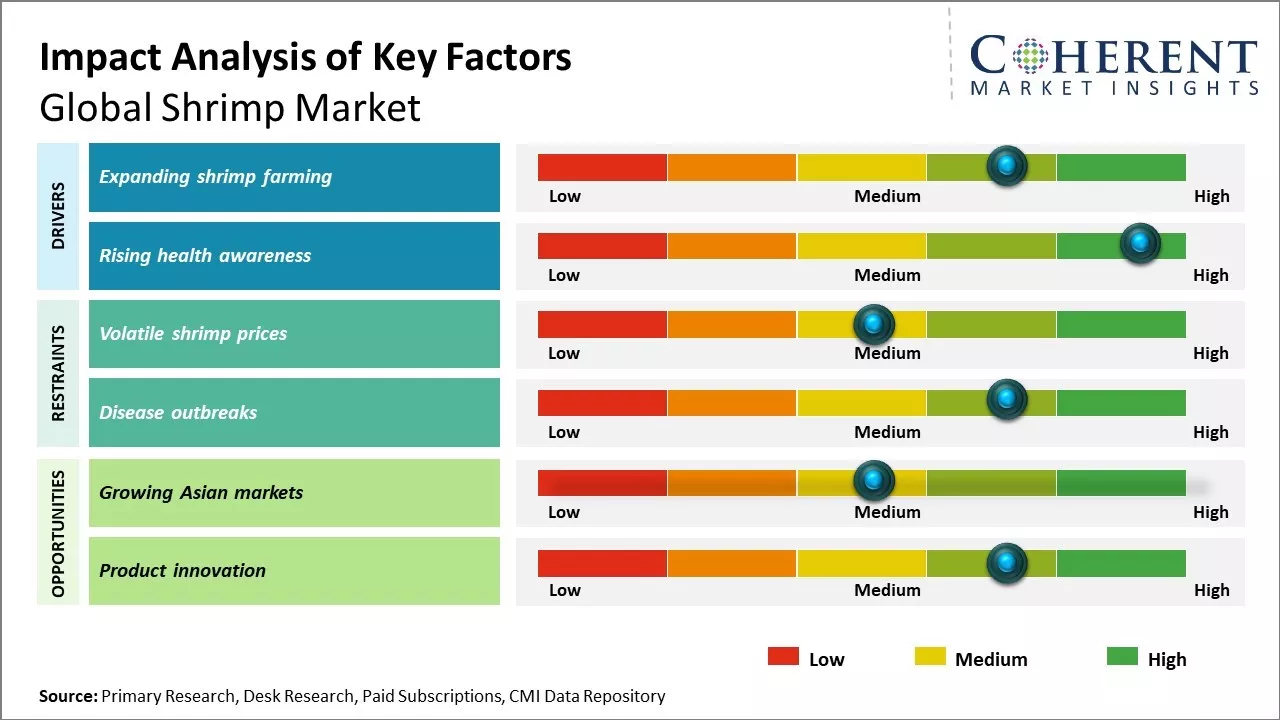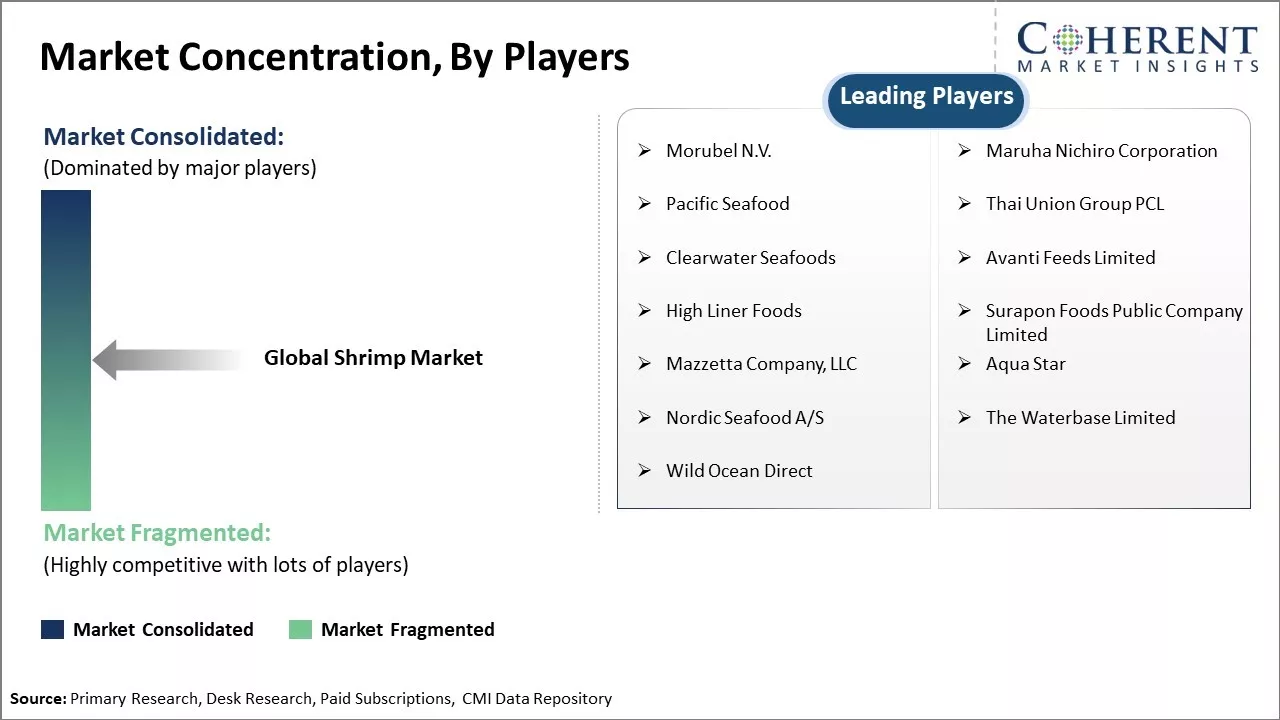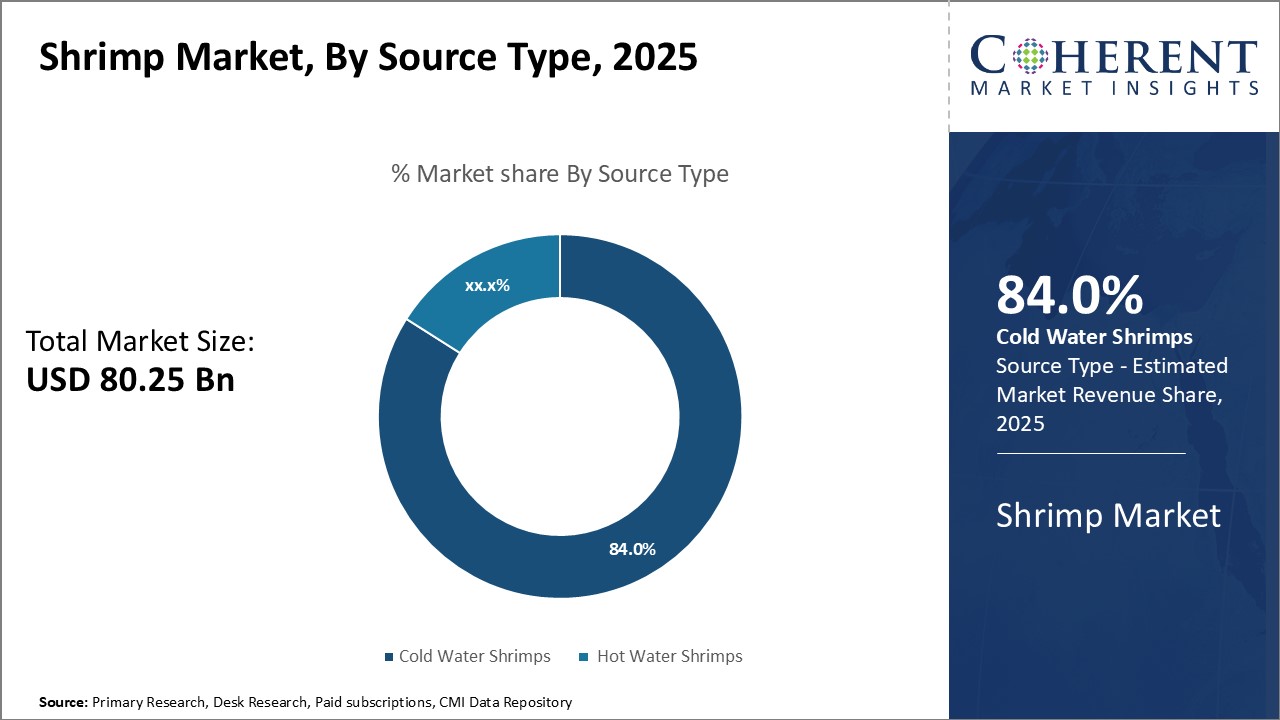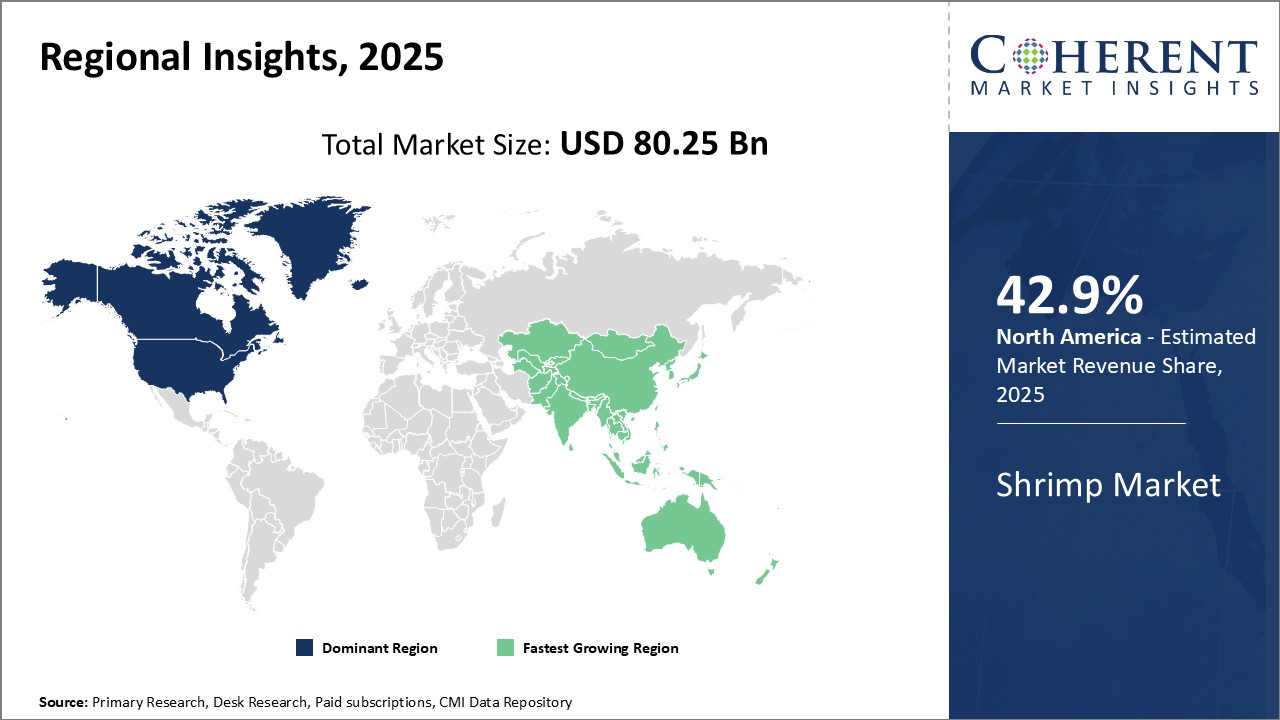The shrimp market is estimated to be valued at USD 80.25 Bn in 2025 and is expected to reach USD 117.60 Bn by 2032, exhibiting a compound annual growth rate (CAGR) of 5.6% from 2025 to 2032.

Discover market dynamics shaping the industry: Request sample copy
The global shrimp market has been witnessing positive growth over the past few years. The demand for shrimp is increasing globally due to its high nutritional value and various health benefits. Shrimp is a rich source of protein and contains other nutrients like vitamins and minerals. It is also low in calories, making it a preferred choice. Moreover, increasing seafood restaurants and the online selling of shrimp products have boosted the market growth. However, environmental issues related to overharvesting and diseases affecting shrimp farming could pose a challenge to the market growth. Regulations related to sustainable shrimp farming need to be complied with carefully.
Expanding shrimp farming
The global demand for shrimp has been steadily rising in the recent decades. As the population and income levels grow across regions, especially in developing countries in Asia Pacific and Latin America, consumers are gradually increasing their seafood consumption, with shrimp being one of the most popular choices. In order to meet this ballooning demand, shrimp farming activities around the world have expanded aggressively. Countries such as India, China, Vietnam, Indonesia, and Ecuador have emerged as major shrimp culturing nations to capitalize on the lucrative opportunities.
Shrimp farming is largely done in brackish water conditions, either in ponds along the coastal lines or in tanks with controlled salinity levels. It provides an excellent way to generate income and employment in coastal and island communities. With guidance and support from governments and international organizations, small and marginal fishermen are encouraged to take up shrimp farming as a supplementary livelihood. Large-scale commercial shrimp farms have also come up with advanced hatchery facilities and water recirculation systems to ensure year-round production. Technological improvements in areas such as breeding, feed formulation, disease control, and harvesting have steadily boosted overall yields from shrimp culture. The availability of low-cost labor in many developing markets and subsidies/tax benefits offered by some governments have further spurred multi-fold expansion of the industry.

Get actionable strategies to beat competition: Request sample copy
Rising health awareness
Another important factor propelling the shrimp market growth is the increasing health consciousness among consumers globally. With growing incidents of lifestyle diseases, more people are being attentive towards maintaining a balanced diet and active lifestyle. Shrimp has emerged as a popular choice due to its high nutritional value and low fat content compared to other seafood varieties. It is rich in high-quality protein, vitamin B12, selenium, zinc, and omega-3 fatty acids. Regular consumption of shrimp is credited with various health benefits, such as reducing inflammation and lowering cholesterol, boosting brain function and minimizing risks of chronic conditions.
Awareness about these advantages along with changing preferences towards protein-rich diets have made shrimp a sought-after ingredient. Marketers highlight its health credentials through advertisements, branding, and nutrition guides. Social media further spreads knowledge on cooking various shrimp delicacies. As consumers pay more attention towards ingredient labels, product claims and food miles, farmed shrimp raised in a sustainable manner garners added interest.
Key Takeaways from Analyst:
The global shrimp market continues to grow steadily driven by rising consumer demand and preference for seafood protein.
North America and Europe are other notable markets experiencing stable demand for shrimp. However, overfishing remains a key restraint limiting further growth potential worldwide. Intense shrimp farming practices have also led to rising concerns of disease outbreak and environmental damage in major farming nations. Sustainable farming and implementing proper regulations on fishing quotas can help address these issues over the long run.
Adoption of advanced aquaculture technologies provides a major opportunity for selected countries to boost productivity and meet rising demand.
In the coming years, Vietnam and other Southeast Asian nations are positioned to grow their market share the fastest by ramping up sustainable production through the implementation of new technologies and the best practices. Meanwhile, companies should focus on diversifying sourcing origins and building reliable supply chains to ensure steady supply.
Market Challenges: Volatile shrimp prices
The volatility in shrimp prices has been a major restraint on the growth of the global shrimp market. Shrimp farming and harvesting is heavily dependent on weather patterns, climatic conditions and ocean currents which determine shrimp availability and consequently influence prices. In recent years, occurrences of El Nino phenomena, hurricanes, floods and droughts have disrupted shrimp cultivation in key farming regions and led to significant fluctuation in shrimp output.
Market Opportunities: Growing Asian Market
The growing Asian market offers tremendous opportunities for growth in the global shrimp market. Asia's rising affluence and appetite for high-quality protein presents a massive consumer base that is ripe for shrimp consumption. Countries like China, India, and Vietnam already have strong seafood cultures and witness increasing shrimp demand annually. With economic development and westernization of diets, more Asian consumers now view shrimp as a desirable and prestigious food. Shrimp features heavily in Asian fine dining and is increasingly popular as a quick serve option as well, benefitting from its convenience and versatility.

Discover high revenue pocket segments and roadmap to it: Request sample copy
Insights by Source Type: Product advantages drive demand for cold water shrimps
Cold water shrimps segment is expected to contribute 84.0% share of the shrimp market in terms of source type in 2025, due to their perceived health and quality advantages over other varieties. Cold water shrimp species typically inhabit cooler northern waters and are prized by health-conscious consumers for their high protein and omega-3 fatty acid content. These nutrients provide notable heart health and cognitive benefits. Research increasingly links diets rich in seafood like cold water shrimp to reduced risk of many chronic diseases.
The omega-3 fatty acids EPA and DHA found abundantly in cold water shrimp also support brain and eye health throughout life. Studies show these fatty acids are essential for nerve signaling and cellular communication. They may play a protective role against age-related cognitive decline and retina degeneration. Expectant mothers who eat shrimp receive these crucial nutrients for fetal development as well.
From a quality standpoint, cold water shrimp develop a sweet, delicate flavor profile many consumers prefer. Their flesh tends to stay firmer and moister during cooking compared to other types. Celebrated chefs highlight cold water shrimp's versatility for diverse preparations from scampi to salads to ceviches. Prominent global brands emphasize traceability and sustainability attributes to satisfy growing eco-conscious demand in market segments. These factors drive consumers' enduring loyalty to cold water shrimp despite its often-higher price point.
Insights by Species: Versatility and familiarity drive the demand for farmed Whiteleg shrimps
Farmed Whiteleg Shrimps segment is expected to account for the 33.9% share of the shrimp market in terms of species in 2025. They are a popular choice due to a combination of availability, familiarity and culinary versatility. As the most widely farm-raised shrimp globally, Whiteleg Shrimps can be found year-round in a variety of product forms. Consumers develop trust from consistent positive experiences selecting and cooking them. While not as exotic as some species, their ubiquitous presence and reasonable price create strong brand recognition over time.
Whiteleg Shrimps adapt well to intensive aquaculture production methods. Advanced farming techniques achieve harvests on a scale impossible with wild-catch alone. This supply reliability meets bulk demand from food service and retail sectors worldwide. Processors work with farms to deliver products standardized for size, peel count and other attributes tailored to customers' needs. With consistent volume output come lower per-unit costs, retaining Whiteleg Shrimps' competitive advantage versus premium wild or specialty farmed varieties.
Versatile preparation further raises Whiteleg Shrimps' popularity baseline. Their mild flavor and delicate texture suit diverse cuisines from classic shrimp cocktails and boils to stir-fries, pastas, curries, and others. Both peeled and shell-on forms offer cooking flexibility. Consumer recipe exploration strengthens brand loyalty and willingness to experiment with new product forms like breaded, roasted or seasoned items. This drives demand across market segments on supermarket shelves and restaurant menus alike.
Insights by Form: Convenience drives the demand for frozen shrimp
In terms of form, frozen segment is expected to account for 37% of the market share in 2025, due to its unmatched convenience compared to other formats. Freezing preserves shrimp's freshness, flavor and nutrition for much longer than alternative preservation methods. It allows supply to exceed fleeting local seasons and satisfy year-round consumption demand. Frozen shrimp retains a reputable quality standard, reassuring time-pressed buyers.
Consumers lead busy modern lifestyles with less time spent meal planning and cooking from scratch. Frozen shrimp shortens prep work with minimal thawing and cleaning required. Its ready-to-cook attribute fits flexible dinner routines. Home chefs appreciate control over precisely the amount needed to top pasta, stir-fry vegetables or add to chowders without waste.
Frozen shrimp also dominates food industry applications. Commercial and institutional foodservice sectors rely heavily on the format for ingredient versatility and operational efficiency. Quick thawing delivers consistency for batched menu items. It ensures suppliers meet fluctuating daily demand at restaurants and events. Retailers also favor shrimp's long frozen shelf life of 9-12 months for logistics planning flexibility. As global travel and immigration shift diets more international, demand grows for authentic ethnic flavors. Frozen shrimp allows recipe exploration of beloved cuisines requiring specialty varieties not locally caught. Its accessibility opens new commercial opportunities meeting niche demands that would otherwise go unsatisfied. This drives volumes across broad demographic segments.

Need a Different Region or Segment? Customize now
North America has long been the dominant region in the global shrimp market. The region is expected to account for 42.9% of the market share in 2025, particularly led by the U.S. The large population and high seafood consumption have supported strong and steady demand in the region for decades. The frozen shrimp segment dominates sales, with various processing facilities distributing products nationwide to major grocery retailers and restaurants. A developed aquaculture industry has also supplemented robust wild catches to maintain supply. While much of the shrimp supply has traditionally been imported, strong domestic aquaculture production in countries like Mexico and Ecuador in recent years have increased their share exported to North America. Nevertheless, South Asian nations particularly India and Vietnam continue to dominate North American shrimp imports with their competitive costs and reliable quantities. Their shrimp prices have influenced pricing benchmarks across the entire North America market.
A fast-rising force has emerged in Asia Pacific has experienced exponential shrimp market growth over the past 10 years. Led by Thailand and Indonesia, several Southeast Asian countries have aggressively expanded shrimp farming. Their climatic conditions are extremely well-suited for producing large shrimp crops year-round. Asia Pacific has increasingly become a key shrimp supplier and processing hub not only for neighboring Asian markets but also exports further abroad. More multinationals in the seafood industry have also established shrimp processing facilities in ASEAN to leverage its lower production costs and tap growing intra-Asian trade flows. Large retailers and food service buyers have augmented their direct sourcing from the region to meet rising demand from populations in East and South Asia. Certain processed shrimp segments like breaded and prepared meals have seen their sales soar across Southeast Asian countries as busy lifestyles drive convenient frozen options.
Shrimp Market Report Coverage
| Report Coverage | Details | ||
|---|---|---|---|
| Base Year: | 2024 | Market Size in 2025: | USD 80.25 Bn |
| Historical Data for: | 2020 To 2024 | Forecast Period: | 2025 To 2032 |
| Forecast Period 2025 to 2032 CAGR: | 5.6% | 2032 Value Projection: | USD 117.60 Bn |
| Geographies covered: |
|
||
| Segments covered: |
|
||
| Companies covered: |
Morubel N.V., Maruha Nichiro Corporation, Pacific Seafood, Thai Union Group PCL, Clearwater Seafoods, Avanti Feeds Limited, High Liner Foods, Surapon Foods Public Company Limited, Mazzetta Company, LLC, Aqua Star, Nordic Seafood A/S, The Waterbase Limited, and Wild Ocean Direct |
||
| Growth Drivers: |
|
||
| Restraints & Challenges: |
|
||
Uncover macros and micros vetted on 75+ parameters: Get instant access to report
*Definition: "This premium shrimp product is sourced directly from small artisanal shrimp farms along the coast. The shrimp are hand-peeled daily and never frozen to ensure the highest quality. Only the largest shrimp with intact shells are selected to be quickly boiled, cooled, and packaged fresh for customers. This process allows the natural sweet flavor and firm texture of the shrimp to shine through. As a result, home cooks and professional chefs alike rely on this market's fresh shrimp to take their coastal cuisine to the next level."
Share
Share
About Author
Yash Doshi is a Senior Management Consultant. He has 12+ years of experience in conducting research and handling consulting projects across verticals in APAC, EMEA, and the Americas.
He brings strong acumen in helping chemical companies navigate complex challenges and identify growth opportunities. He has deep expertise across the chemicals value chain, including commodity, specialty and fine chemicals, plastics and polymers, and petrochemicals. Yash is a sought-after speaker at industry conferences and contributes to various publications on topics related commodity, specialty and fine chemicals, plastics and polymers, and petrochemicals.
Missing comfort of reading report in your local language? Find your preferred language :
Transform your Strategy with Exclusive Trending Reports :
Frequently Asked Questions
Joining thousands of companies around the world committed to making the Excellent Business Solutions.
View All Our Clients
US Reciprocal Tax Impact Analysis On Shrimp Market
Stay updated on tariff changes with expert insights and timely information